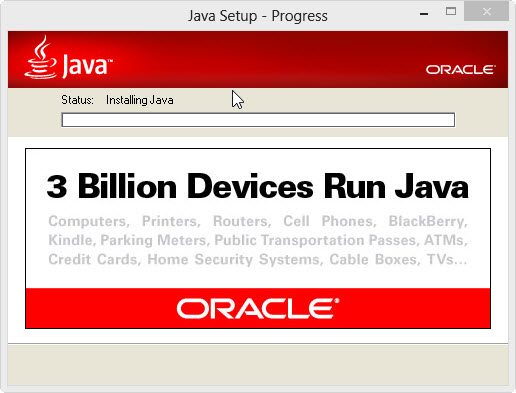Download Java 8 Update 101 64 Bit Offline Installer
We don't have any change log information yet for version 8.0-build-271 of Java Runtime Environment 64-bit. Sometimes publishers take a little while to make this information available, so please check back in a few days to see if it has been updated.
Oracle has released “Java Platform, Standard Edition 8 Update 161” also known as ‘Java Runtime Environment Version 8.0 Update 161’.

- The default installation directory of a static JRE (prior to JDK 9) is C: Program Files (x86) Java jre n (for 32-bit versions) or C: Program Files Java jre n (for 64-bit versions), where n was the full Java SE release and update number (for example, n = 18.020 for JRE release 8 update 20).
- Silent installation and uninstallation switches for Java 8 Update 101 (64-bit). Making users install it themselves at their convenience. 64-bit: Download Path.
This release contains fixes for security vulnerabilities.
First of all download and run either jre-8u161-windows-i586.exe for Windows 7 / 8 / 8.1 / 10 / XP 32-bit or jre-8u161-windows-x64.exe for Windows 7 / 8 / 8.1 / 10 / XP 64-bit. If you use 32-bit and 64-bit browsers interchangeably, you will need to install both 32-bit and 64-bit Java in order to have the Java plug-in for both browsers. These offline installers are available in the Java SE Runtime Environment 8 Downloads section of Oracle’s Java website.
When the License Agreement screen pops up, look in the “c:Documents and Settings<username>Local SettingsApplication DataOracleJavajre1.8.0_161 directory” when you’re using Windows XP or “C:Users<username>AppDataLocalLowOracleJavajre1.8.0_161” when your’re using Windows 7 / 8 / 8.1 / 10.
For the x64 version look in the “C:Users<username>AppDataLocalLowOracleJavajre1.8.0_161_x64” directory. In that directory you will find the ‘jre1.8.0_161.msi‘. The jre1.8.0_161 msi file is the one we can use to deploy “Java Runtime Environment Version 8.0 Update 161” by using MSI technology.
Start up the AdminStudio Tuner and create a response transform file. It’s as simple as that if you want to do a default deployment. For an advanced deployment you can further tweak you J2RE configuration two ways:
- by changing the ‘Setup Properties’
- by changing registry settings
The result is the same. You can change some basic ‘Setup Properties’ in the Tuner:
- AUTOUPDATECHECK – Java Update mechanism – on {1} or off {0}
- EULA – popup the EULA when you first start a Java applet – on {1} or off {0}
- IEXPLORER – indicates that the Plug-in should be registered with the Internet Explorer browser – on {1} or off {0}
- JAVAUPDATE – indicates that the Java Update feature should be disabled (the Update tab in the Java Plug-in Control Panel will not appear) – on {1} or off {0}However, it seems that using the property doesn’t work anymore and that you have to set this registry key additionally:[HKEY_LOCAL_MACHINESOFTWAREJavaSoftJava UpdatePolicy]“EnableAutoUpdateCheck”=dword:00000000
- MOZILLA – indicates that the Plug-in should be registered with Mozilla 1.1 and later browsers – on {1} or off {0}
- WEB_JAVA – if used, disables any Java application from running in the browser. WEB_JAVA=1, the default, enables Java applications in the browser. This field is available as of the 7u10 release. For more information, see Setting the Security Level of the Java Client.
- WEB_JAVA_SECURITY_LEVEL, if used, sets the security level of unsigned Java apps running in a browser. The possible values for this field are V (very high), H (high), M (medium, the default) or L (low). This field is available as of the 7u10 release. For more information, see Setting the Security Level of the Java Client.
Download Java 8 Update 101 64 Bit Offline Installer Mac
… but you can also collect the JRE’s registry settings to tweak the JRE a little more.
Launch the “Java Control Panel” (available in c:Program FilesJavajre8binjavacpl.exe). Most settings you will change by using this utility will then be stored in the registry in [HKEY_LOCAL_MACHINESOFTWAREJavaSoft]. Some examples:
Download Java 8 Update 101 64 Bit Offline Installer Windows 10
- Click on the “Update” tab. If you uncheck the “Check for Update Automatically” you will shutdown the Java Update mechanism. This may be wise, because we want to deploy newer versions by using ZENworks and not automatically by using the Java Update mechanism.
- If you want to disable the ‘Update’ tab, then use this registry setting to enable (00000001) or disable it (00000000):[HKEY_LOCAL_MACHINESOFTWAREJavaSoftJava UpdatePolicy]“EnableJavaUpdate”=dword:00000000
Download Java 8 Update 101 64 Bit Offline Installer Download
Some settings however are stored somewhere else. Some examples:
Download Java 8 Update 101 64 Bit Offline Installer 64-bit

- Click on the “Advanced” tab. If you open up the “Miscellaneous” node by clicking on the + sign, you can check or uncheck “Place Java icon in system tray”. Which just does what is says. Now it has become more difficult for users to fiddle around with the J2RE configuration. This setting is stored in:C:Documents and Settings%USERNAME%AppDataSunJavaDeploymentdeployment.properties.as: “deployment.system.tray.icon=true”
- Click on the “General” tab. Click on ‘Network Settings’. The settings you configure are also stored in the deployment.properties file.This ‘deployment.properties’ file is used for storing and retrieving deployment configuration properties in the Java Control Panel. They are also used for customizing runtime behavior for both Java Plug-in and Java Web Start. There is always a User-Level deployment.properties file. Its location, which is non-configurable, is described here. There may also be an (optional) System-Level deployment.properties file. If it exists, its location is determined by a System Administrator through the deployment.config file as described here.
You can add a Custom Action (1122) to your Transform file, where you run this command:
cmd.exe /C rmdir “%PROGRAMDATA%MicrosoftWindowsStart MenuProgramsJava” /S
to remove the Start Menu shortcuts. In the InstallUIExecuteSequence table you set the Sequence ID of this Custom Action to ‘3183’. Which is then between the InstallJava custom action (3181), which apparently create these shortcuts, and InstallFinalize (3185).